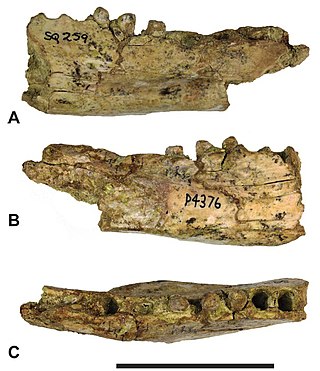
The order Peramelemorphia includes the bandicoots and bilbies. All members of the order are endemic to Australia-New Guinea and most have the characteristic bandicoot shape: a plump, arch-backed body with a long, delicately tapering snout, very large upright ears, relatively long, thin legs, and a thin tail. Their size varies from about 140 grams up to 4 kilograms, but most species are about one kilogram.

Thylacinidae is an extinct family of carnivorous marsupials from the order Dasyuromorphia. The only species to survive into modern times was the thylacine, which became extinct in 1936.

Thylacinus is a genus of extinct carnivorous marsupials in the family Thylacinidae. The only recent member was the thylacine, commonly also known as the Tasmanian tiger or Tasmanian wolf. The last known Tasmanian tiger was in the Beaumaris Zoo in Tasmania, eventually dying in 1936. The earliest known member of the genus, Thylacinus macknessi appeared during the Early Miocene, around 16 million years ago, and was smaller than the modern thylacine, with a body mass of about 6.7–9.0 kilograms (14.8–19.8 lb). Thylacinus represented the only extant genus of the family after the beginning of the Pliocene around 5 million years ago. Over time members of the genus saw an increase in body mass and a greater adaption to hypercarnivory in their dental morphology.

Australidelphia is the superorder that contains roughly three-quarters of all marsupials, including all those native to Australasia and a single species – the monito del monte – from South America. All other American marsupials are members of the Ameridelphia. Analysis of retrotransposon insertion sites in the nuclear DNA of a variety of marsupials has shown that the South American monito del monte's lineage is the most basal of the superorder.
Yalkaparidon is an extinct genus of Australian marsupials, first described in 1988 and known only from the Oligo-Miocene deposits of Riversleigh, northwestern Queensland, Australia.

Thylacoleonidae is a family of extinct carnivorous diprotodontian marsupials from Australia, referred to as marsupial lions. The best known is Thylacoleo carnifex, also called the marsupial lion. The clade ranged from the Late Oligocene to the Late Pleistocene, with some earlier species the size of a possum, while the youngest members of the family belonging to the genus Thylacoleo reached sizes comparable to living big cats.

Badjcinus is an extinct thylacinid marsupial. It is the earliest and most primitive known thylacinid, living 23 to 28 million years ago in the late Oligocene.

Wakaleo is an extinct genus of medium-sized thylacoleonids that lived in Australia in the Late Oligocene and Miocene Epochs.

The genus Nimbacinus contains two species of carnivorous, quadrupedal marsupials in Australia both of which are extinct:
Thylacinus macknessi lived during the early Miocene and is the oldest known member of the genus Thylacinus. It is named after Brian Mackness, a supporter of Australian vertebrate paleontology.

Thylacinus megiriani lived during the late Miocene, 8 million years ago; the area T. megiriani inhabited in the Northern Territory was covered in forest with a permanent supply of water.
Maximucinus is an extinct genus of thylacinid that lived during the Middle Miocene in what is now Queensland, Australia. It is known only a second upper molar found at the Riversleigh World Heritage Area. It was the largest thylacinid of its time, attaining a body size of 18 kg. The genus is monotypic, containing only one species, Maximucinus muirheadae.
Mutpuracinus archibaldi is an extinct carnivorous, quadrupedal marsupial that lived during the middle Miocene and is the smallest known thylacinid at approximately 1.1 kilograms, the size of a quoll, though, more closely related to the recently extinct thylacine.

Ngamalacinus is an extinct genus of thylacinid marsupial that lived during the late Oligocene and early Miocene of Australia. Fossils have been found in Riversleigh.
Tyarrpecinus is an extinct genus of thylacinid that lived during the late Miocene in what is now the Northern Territory, Australia. It is known only from a partial skull bone that was reconstructed from numerous fragments. It was a small thylacinid and represents a late surviving relict. The genus is monotypic, containing only one species, Tyarrpecinus rothi.
Wabulacinus ridei lived during the early Miocene in Riversleigh. It is named after David Ride, who made the first revision of thylacinid fossils. The material was found in system C of the Camel Spurtum assembledge.
The Macropodidae are an extant family of marsupial with the distinction of the ability to move bipedally on the hind legs, sometimes by jumping, as well as quadrupedally. They are herbivores, but some fossil genera like Ekaltadeta are hypothesised to have been carnivores. The taxonomic affiliations within the family and with other groups of marsupials is still in flux.
Joculusium muizoni is a fossil species discovered at the Riversleigh World Heritage Area. Little is known about the animal.
Lekaneleo is a fossil genus of carnivorous marsupial that existed during the early Miocene in Australia. Once allied to the type species of the genus Priscileo, later placed as Wakaleo pitikantensis, "Priscileo" roskellyae was subsequently transferred to its own genus Lekaneleo.

Thylacinus yorkellus is a fossil species of carnivorous marsupial, a sister species of the recently extinct Thylacinus cynocephalus, the Tasmanian tiger, both of which existed on mainland Australia.














